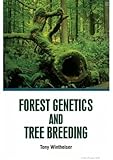Forest genetics and tree breeding / by Tony Wintheiser.
Material type: TextPublication details: New Orleans, LA : White Press Academic, c2023.Description: x, 290 pages : b&w illus. ; 26 cmISBN:
TextPublication details: New Orleans, LA : White Press Academic, c2023.Description: x, 290 pages : b&w illus. ; 26 cmISBN: - 9781799600817
- Ref 575.1 W73f 2023.
| Item type | Current library | Collection | Call number | Status | Barcode | |
|---|---|---|---|---|---|---|
 Books
Books
|
ASCOT Library - Zabali Campus Reference | Reference | Ref 575.1 W73f 2023. (Browse shelf(Opens below)) | Available | Ref5751004756 |
Browsing ASCOT Library - Zabali Campus shelves, Shelving location: Reference, Collection: Reference Close shelf browser (Hides shelf browser)

|

|

|

|

|

|

|
||
| Ref 551.6 Im71i 2022 C2 Impact of climate change on hydrological cycle, ecosystem, fisheries and food security / | Ref 571 P88e 2023. Environmental physiology / | Ref 574.5 Es74e 2023. Essentials of ecology: world edition / | Ref 575.1 W73f 2023. Forest genetics and tree breeding / | Ref 577 M61l 2021 Living in the environment / | Ref 577.14 D49e 2023. Environmental chemical and hydrological cycle / | Ref 577.22 Q44i 2023 C1 Climate change handbook / |
Includes bibliographical references and index.
Chapter 1. Forest genetics --
Chapter 2. Tree breeding --
Chapter 3. Genetic concepts in tree breeding --
Chapter 4. Forest genetics and tree improvement --
Chapter 5. Selection as a method of tree breeding --
Chapter 6. Current developments in tree genetics --
Chapter 7. Forest mensuration --
Chapter 8. Forest wood and its utilization.
"Forestry sector is considered one of the most developed in the world, being the base for important industrial segments which use wood as raw material. Tree breeding has played an important role on improving the competitiveness of forestry-based companies, especially for its positive reflexes on increasing adaptation, forestry productivity and wood quality. Forest trees meet human needs and contribute to natural ecosystems in unique and diverse ways. As a source of fuel and fiber, they are important commodities. As dominant members of many natural ecosystems, they play keystone ecological roles in plant and animal communities. As habitat for other organisms, forests are a reservoir of great natural diversity. Forest Genetics examines some of the basic genetic concepts typically used in forestry and tree improvement studies, including Mendelian and population genetics. It also describes techniques that are generally useful in tree improvement work, including individual tree selection and breeding, provenance testing, species and racial hybridization, and introduction of exotics. Describing the genetic diversity and composition of forest tree populations is crucial for understanding the evolution and biogeography of tree species, and for guiding strategies that identify and protect endangered populations. Researchers are identifying unique and endangered populations, and using population genetic tools to understand the effects of environmental change, habitat fragmentation, and invasive species on the long-term survival of tree populations. Sufficient genetic diversity ensures the success of our forest tree species in a highly variable environment. Safeguarding genetic diversity and resources is an important part of biodiversity conservation and a goal to which Finland has committed through international conventions. Genetic diversity refers to the variability between specimens within a species. The present book has been designed as a text-cum-reference book for post-graduate students, research workers, teachers and undergraduate students specializing in advance course of forest genetics and tree improvement. It is believed, the book will immensely benefit them all." -- Book cover
There are no comments on this title.
